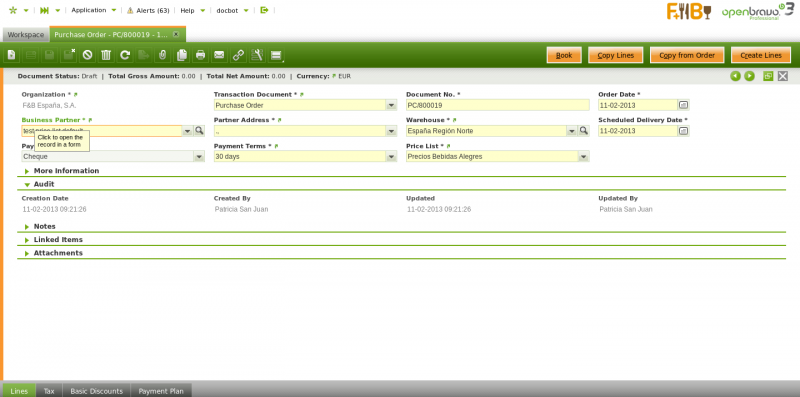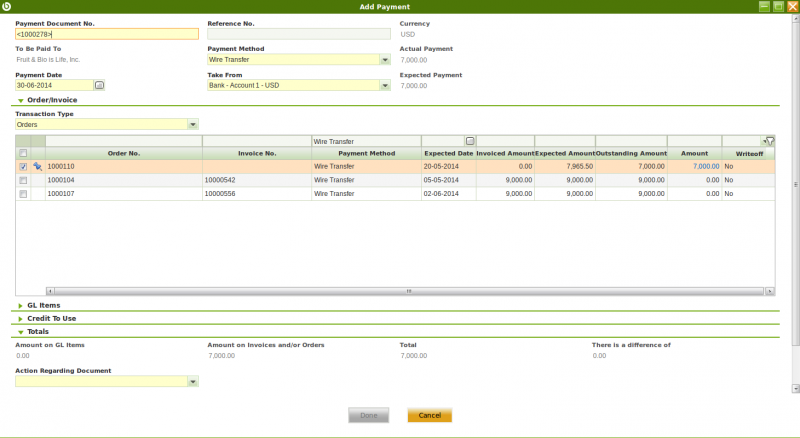Difference between revisions of "Purchase Order"
(→Header) |
(→Header) |
||
| Line 43: | Line 43: | ||
[[Image:Purchase Order AddPayment 0.png]] | [[Image:Purchase Order AddPayment 0.png]] | ||
| − | Same as described for [[Purchase Invoice|Purchase Invoice Payment]], this window allows to fully or partially prepaid the order created more than once, and even pay other orders and/or invoices at the same time. | + | Same as described for [[Purchase Invoice#Payment|Purchase Invoice Payment]], this window allows to fully or partially prepaid the order created more than once, and even pay other orders and/or invoices at the same time. |
It is also possible to add any type of expense related to the payment of that order as a G/L item and even use [[Payment Out|available credit]] previously generated for the vendor. | It is also possible to add any type of expense related to the payment of that order as a G/L item and even use [[Payment Out|available credit]] previously generated for the vendor. | ||
Revision as of 11:37, 24 October 2018
| Back to Procurement Management |
Contents
Introduction
Purchase Order window allows the procurement team to create and manage orders which once booked will be sent to the external suppliers. In other words, it is a document to register products and/or services to be purchased and documented against what conditions. Once the document is booked, it can be sent to the external supplier by mail or email and it can be prepaid if required.
Normally the "procurement" role is in charge of managing this stage of the chain which usually comes after "Requisition" creation and management. However that's not always true, Purchase orders can also be created from the scratch without the need of a previously created purchase requisition.
Starting from here, you will learn how to create and manage "Purchase Orders" in Openbravo.
Header
Purchase orders can be created and booked in the header section of the purchase order window. Purchase order header allows you to enter below information:
- Transaction Document, which in this case is defaulted as "Purchase Order".
- Document No, or the Company purchase order number.
- Order Date. This date is also defaulted by Openbravo based on the system date, but it can always be changed.
- Business Partner. End-user needs to select the supplier to which the purchase order is being issued.
- Partner Address. Automatically populated once the business partner is selected based on the address or location set us "Ship to Address".
- Warehouse. Regardless it is defaulted by Openbravo based on the "Profile" selected options, it must be verified by the end-user.
- Scheduled Delivery Date. This is the date when the organization or legal entity requires the items to be delivered.
- Payment Method, Payment Terms and Price List. These ones are defaulted by Openbravo once a business partner is selected.
- Order Reference, free text which can be found under "More Information" section, you can use to save the supplier order number, if any.
Once header information is properly filled-in, you can then go to the "Lines" tab in order to enter purchase order line/s information.
To learn how to enter purchase order lines, visit the next section "Lines".
It is possible to take up to three possible actions regarding a purchase order, by using the header button "Book":
- Process it, in case you might want to process it but not to book it as final, because it could be you might need to change it later on.
- Void it, in case that purchase order is not required anymore and therefore needs to be voided.
- Book it, in case it is correct and final.
If there are non-stockable BOM products and they have not been exploded, the Book button will explode them automatically.
Purchase order prepayment Once a purchase order is booked, it is possible to prepay an order by using the process button "Add Payment".
Openbravo shows "Add Payment" window.
Same as described for Purchase Invoice Payment, this window allows to fully or partially prepaid the order created more than once, and even pay other orders and/or invoices at the same time.
It is also possible to add any type of expense related to the payment of that order as a G/L item and even use available credit previously generated for the vendor.
Once all of that is properly fulfilled, the payment can be processed or processed and withdrawn from the financial account.
It is important to remark that the purchase invoice created from the order will inherit the payment done for the order.
Lines
Once the purchase order header has been properly filled in and saved, each purchase order line can be created in this tab.
Purchase order lines can be created in three different ways:
1. By manually creating new record/s in the "Lines" tab.
The purchase order fields you can fill in are described below:
- Product. You can select an item or product from the list or use the product selector icon.
- Ordered quantity, or Operative Quantity if the product has an alternative unit of measure (AUM) configured.
This is the quantity needed of the product/item - Product's UOM, or product's Alternative UOM depending on product configuration in regards to unit of measure.
- Net Unit Price. This one is coming from the Price List selected in the header, but it could always be changed.
- Net List Price. This one is also coming from the Price List selected in the header, but it could always be changed.
- Tax. Purchase tax is normally filled in by the system, depending on Taxes setup.
To learn more about taxes, please visit Tax Rate
2. By retrieving all the lines from a previously created purchase orders.
In this scenario you must use the process button "Copy from Orders".
This process button enables the Copy from Orders Pick and Edit window.
"Copy from Orders Pick and Edit" window allows you to search the orders to copy by using the filter options available.
The lines information of the selected orders will be inserted in the purchase order line/s, then that information can be manually changed anyway.
3. By copying lines from other purchase orders In this scenario you must use the process button "Copy Lines" This process button enables a new window named "Copy Lines from order" which allows you to create order lines by selecting the products already purchased from the supplier of the order by taking into account the Consumption days configured for the supplier.
Explode button Explode button is shown when selecting a line with a non-stockable BOM product and the product has not already been exploded. When exploding a product, the bill of materials components the selected product consists of are shown in the order. Once you have exploded it, you cannot comprime it. You should delete all the lines (first bill of materials components and then the BOM product), and insert again the non-stockable BOM product.
Manage Prereservation pick and execute
Using the Manage Prereservation button is possible to open a pick and execute window to manage the Prereservations related to the Purchase Order line. The grid shows all the Sales Orders pending to deliver that could be served by the stock that will be received in the Purchase Order Line. If the Sales Order wasn't previously reserved a new reservation in Draft status is created for it.
Line Tax
For each purchase order line, Openbravo automatically populates the line tax related information in this tab.
Line tax tab informs about each purchase order line:
- applied tax rate
- taxable amount
- and calculated tax amount
It is not possible to either manually create a new line or modify existing ones.
Prereserved Qty
Relation of Reservations where the Purchase Order line has been used as prereservation.
Basic Discounts
Lists information about discounts automatically applied based on the supplier configuration and / or manually entered for the purchase order.
Tax
Summarized purchase order tax related information is shown in this tab.
Therefore, there will be as many records in this tab as tax rates used in the purchase order. Each tax record will show summarized information about:
- the total taxable amount for that tax rate
- and the calculated tax amount for each tax rate
Payment Plan
Shows the total amount expected to be paid upon order booking as well as the amount/s pre-paid or paid against the invoice/s for the order.
Payment Plan information is required at order level because suppliers could ask for a pre-payment of all or part of a debt prior to its due date. To learn more about "Pre-payments", visit Receivables & Payables.
Purchase order payment plans do not show nor manage valid due dates, but the payment plan of the corresponding purchase invoice/s.
Besides the above this tab also shows information about the regular payments received againts the invoice/s for this order, as amounts paid.
Finally, a payment plan of a purchase order will be removed:
- if the purchase order is reactivated
- or if the purchase order is voided
Please visit Commons Section for more details.
Payment Details
Displays the details of the payments (pre-payments or regular payments) made for the order or for the invoice/s of the order.
To Learn more about "pre-payments", visit Payment Out.
| Back to Procurement Management |



